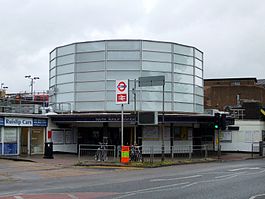South Ruislip station
| South Ruislip |
|
|---|---|

Station building
|
|
|
Location of South Ruislip in Greater London
|
|
| Location | South Ruislip |
| Local authority | London Borough of Hillingdon |
| Managed by | London Underground |
| Owner | London Underground |
| Station code | SRU |
| DfT category | F1 |
| Number of platforms | 4 |
| Fare zone | 5 |
| London Underground annual entry and exit | |
| 2012 |
|
| 2013 |
|
| 2014 |
|
| 2015 |
|
| National Rail annual entry and exit | |
| 2011–12 |
|
| 2012–13 |
|
| 2013–14 |
|
| 2014–15 |
|
| 2015–16 |
|
| Key dates | |
| 1906 | Tracks laid (GW&GCR) |
| 1908 | Opened (GW&GCR) |
| 1948 | Started (Central line) |
| Other information | |
| Lists of stations | |
| External links | |
| WGS84 | 51°33′23″N 0°23′56″W / 51.5565°N 0.3988°WCoordinates: 51°33′23″N 0°23′56″W / 51.5565°N 0.3988°W |
|
|
|
South Ruislip is a station served by London Underground and Chiltern Railways in South Ruislip in west London. The station is owned, managed and staffed by London Underground. The station is in Travelcard Zone 5.
The GWR/GCR Joint line to High Wycombe carried services from both Paddington and Marylebone. They met at Northolt Junction, situated slightly to the east of the station, from where four tracks ran westwards to Ruislip Gardens and West Ruislip; there the route shrank to two tracks only. Opened on 1 May 1908 and originally known as Northolt Junction, the station became South Ruislip & Northolt Junction from September 1932 and received its present name on 30 June 1947.
The station was designed by Brian Lewis and F.C.C. Curtis and first served by Central line trains on 21 November 1948 when the Central line extension from London towards West Ruislip was completed after being delayed by World War II. The rounded booking hall was not completed until 1960. The concrete, glass and granite chip frieze in the booking hall is one of the earliest public works by glass artist, Henry Haig.
In late 1973 and early 1974 the track layout was simplified and the manual signal box was removed in early 1990, along with other manual signal boxes on this line, and its function replaced by colour light signalling and power operated points, both controlled from Marylebone. The track alignments were improved to allow higher speed running at the junction for the services from Marylebone, and the pointwork which had allowed trains from Paddington to call at the westbound Chiltern station platform was removed. All eastbound services were moved to the former through road; the eastbound road, which had formerly extended from the platform road at West Ruislip, was closed and lifted, and the eastbound platform widened. The alignment of the turnout towards Marylebone was improved to allow higher-speed running. Fragments of the old trackwork can still be seen to the north of the line at this point. The trackwork at this station has been upgraded and now permits higher speed running up to 100 miles per hour (160 km/h).
...
Wikipedia

